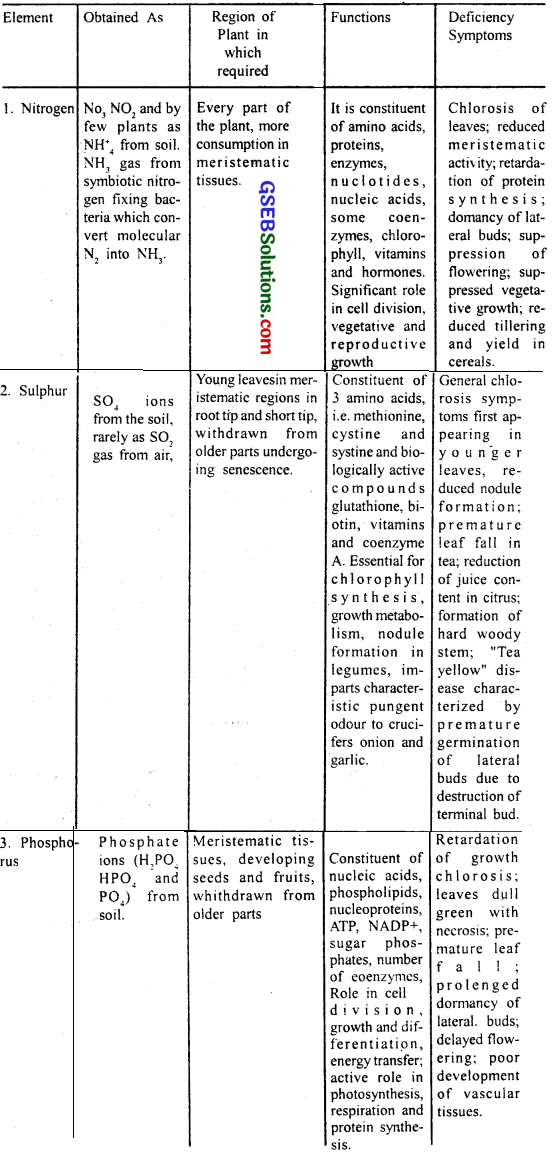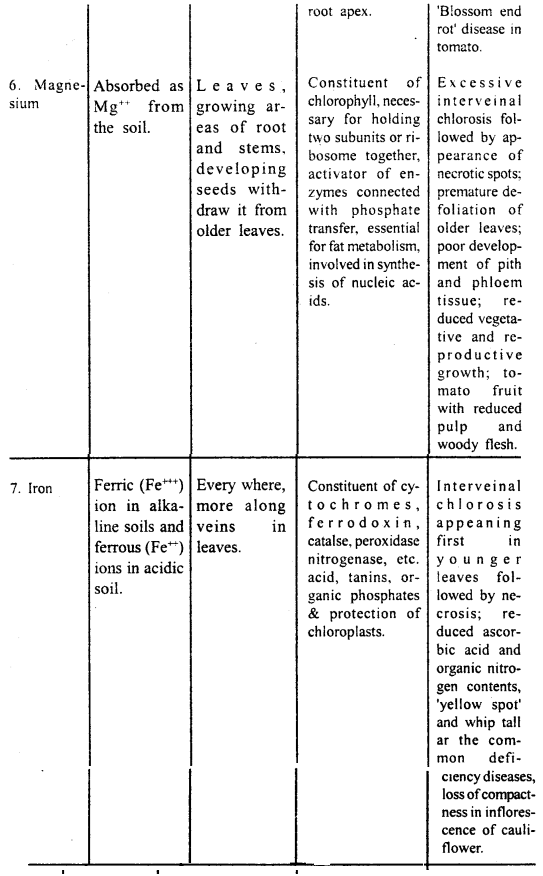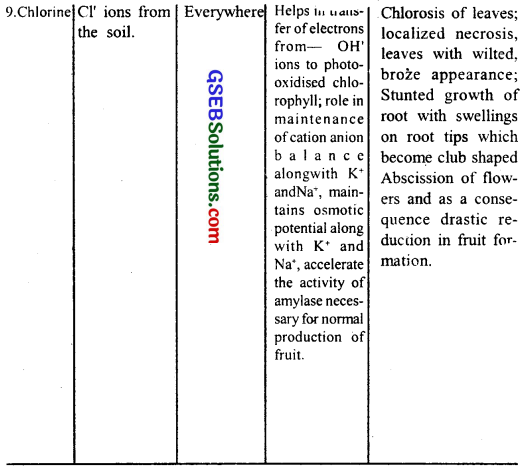Gujarat Board GSEB Textbook Solutions Class 11 Biology Chapter 12 Mineral Nutrition Textbook Questions and Answers.
Gujarat Board Textbook Solutions Class 11 Biology Chapter 12 Mineral Nutrition
GSEB Class 11 Biology Mineral Nutrition Text Book Questions and Answers
Question 1.
“All elements that are present in a plant need not be essential to its survival”. Comment.
Answer:
The criteria for the essentiality of an element are given below:
- The element must be absolutely necessary for supporting normal growth and reproduction. In the absence of the element, the plants do not complete their life cycle or set the seeds.
- The requirement of the element must be specific and not replaceable by another element. In other words, the deficiency of any one element cannot be met by supplying some other element.
- The element must be directly involved in, the metabolism of the plant.
Question 2.
Why is the purification of water and nutrient salts so important in studies involving mineral nutrition using hydroponics?
Answer:
In 1860 Julius Sachs, a prominent German botanist, demonstrated, for the first time, that plants could be grown to maturity in a defined nutrient solution in the complete absence of soil. This technique of growing plants in a nutrient solution is known as hydroponics.
Since then, a number of improvised methods Irave been employed to try and determine the mineral nutrients essential for plants. The essence of all these methods involves the culture of plants in a soil-free, defined mineral solution. These methods require purified water and mineral nutrient salts.
After a series of experiments in which the roots of the plants were immersed in nutrient solution and wherein one element was added removed or given in varying concentrations, a mineral solution suitable for the plant growth was obtained. By this method, essential elements were identified and their deficiency symptoms discovered. Hydroponics has been successfully employed as a technique for the commercial production of vegetables such as tomato, seedless cucumber, and Lettuce. It must be emphasized that the nutrient solution must be adequately aerated to obtain optimum growth.
![]()
Question 3.
Explain with examples macronutrients, micronutrients, beneficial nutrients, toxic elements, and essential elements.
Answer:
Macronutrients: Generally present in plant tissues in large amounts. The macronutrients include carbon, hydrogen, oxygen, nitrogen, phosphorus, sulfur, potassium calcium, and magnesium. Of these carbon, hydrogen and oxygen are mainly obtained from CO2 and H2O, while the others are absorbed from the soil as mineral nutrition.
Micronutrients: Also called Trace elements are needed in very small amounts. These include iron, manganese, copper, molybdenum, zinc, boron, chlorine, and nickel.
Beneficial nutrients: Include sodium, silicon, cobalt, and selenium. They are required by higher plants.
Toxic elements: Any mineral ion concentration in tissues that reduces the dry weight of tissues by about 10 percent is considered toxic. The toxicity symptoms are difficult to identify. Micronutrients in excess causes toxicity.
Essential elements: 4 categories on the basis of their diverse functions.
(a) As components of biomolecules and hence structural elements of cells.
e.g. carbon, hydrogen, oxygen, and nitrogen.
(b) As components of energy-related chemical compounds in plants.
e.g. magnesium in chlorophyll
(c) Elements that activate or inhibit enzymes, e.g. Mg2+ is an activator for both ribulose bisphosphate carboxylase oxygenase and phosphoenolpyruvate carboxylase.
(d) Elements that alter the osmotic potential of a cell.
e.g. Potassium in opening and closing of stomata.
![]()
Question 4.
Name at least five different deficiency symptoms in plants. Describe them and correlate them with the concerned mineral deficiency.
Answer:
Deficiency symptoms shown in plants include:
- Chlorosis
- Necrosis
- Stunted plant growth
- Premature fall of leaves/buds and
- inhibition of cell division
Chlorosis is the loss of chlorophyll leading to yellowing in leaves. This symptom is caused by the deficiency of elements N, K, Mg, S, Fe, Mn, Zn, and Mo.
Likewise, necrosis, or death of tissue, particularly leaf tissue, is due to the deficiency of Ca, Mg, Civ K.Lack or low level of N, K, S, Mo causes inhibition of cell division. Some elements like N, S, Mo delay flowering if the concentration in plants is low.
Question 5.
If a plant shows a symptom which could develop due to deficiency of more than one nutrient, how would you find out experimentally the real deficient mineral element?
Answer:
Since each element has one or more specific structural or functional roles in plants, in the absence of any particular element, plants show certain morphological changes. These morphological changes are indicative of certain element deficiencies and are called deficiency symptoms. The deficiency symptoms vary from element to element and they disappear when the deficient mineral nutrient is provided to the plant. However, if deprivation continues, it may subsequently lead to the death of the plant. This way by administering different nutrients and observing the symptoms disappear we can find out experimentally the real deficient mineral element.





![]()
Question 6.
Why is it that in certain plants deficiency symptoms appear first in younger parts of the plant while in others they do so in mature organs?
Answer:
The deficiency symptoms vary from element to element and they disappear when the deficient mineral nutrient is provided to the plant. However, if deprivation continues, it may eventually lead to the death of the plant. The parts of the plants that show the deficiency symptoms also depend on the mobility of the element in the plant. Where elements are actively mobilized within the plant and exported to young developing tissues the deficiency symptoms tend to appear first in the older tissues.
For example, the deficiency symptoms of nitrogen, potassium, and magnesium are visible first in the senescent leaves. In the older leaves, biomolecules containing these elements are broken down, making these elements available for mobilizing to younger leaves.
The deficiency symptoms tend to appear first in the young tissues whenever the elements are relatively immobile and are not transported out of the mature organs. For example, elements like sulfur and calcium are a part of the structural component of the cell and hence are not easily modified.
Question 7.
How are the minerals absorbed by the plants?
Answer:
Plants uptake essential elements from the soil through their roots and from the air through leaves. Nutrient uptake in the soil is achieved by cation exchange, wherein root hairs pump hydrogen ions into the soil through proton pumps. These hydrogen ions displace cations attached to negatively charged soil particles so that the cations are available for uptake by the root. In the leaves, stomata open to take in carbon dioxide and expel oxygen. The carbon dioxide molecules are used as the carbon source in photosynthesis.
![]()
Question 8.
What are the conditions necessary for the fixation of atmospheric nitrogen by Rhizobium? What is their role in NO2 fixation?
Answer:
Several types of symbiotic biological nitrogen-fixing associations are known. The most prominent among them is the legume-bacteria relationship. Species of rod-shaped Rhizobium have-such a relationship with the roots of several legumes such as alfalfa, sweet clover, sweet pea, lentils, garden pea, broad bean, clover beans, etc. The commonest association on roots is nodules. These nodules are small outgrowths on the roots. The microbe, Frankia produces nitrogen-fixing nodules on the roots of non-leguminous plants. Both Rhizobium and Frankia are free-living in soil, but as symbionts, can fix the atmospheric nitrogen.
Question 9.
What are the steps involved in the formation of a root nodule?
Answer:
Nodule formation involves a sequence of multiple interactions between Rhizobium and the roots of the host plant. Principal stages in the nodule formation are summarised as follows:
Rhizobia multiply and colonize the surroundings of roots and gets attached to epidermal and root hair cells. The root-hairs curl and the bacteria invade the root-hair. An infection thread is produced carrying the bacteria into the cortex of the root, where they initiate the nodule formation in the cortex of the root. Then the bacteria are released from the thread into the cells which leads to the differentiation of specialized nitrogen-fixing cells. The nodule thus formed, establish a direct vascular connection with the host for the exchange of nutrients.
The nodule contains all the necessary biochemical components, such as the enzyme nitrogenase and leghaemoglobin. The enzyme nitrogenase is a Mo-Fe protein and catalyzes the conversion of atmospheric nitrogen to ammonia, the first stable product of nitrogen fixation. The reaction is as follows:
![]()
The enzyme nitrogenase is highly sensitive to molecular oxygen; it requires anaerobic conditions. The nodules have adaptations that ensure that the enzyme is protected from oxygen. To protect these enzymes, the nodule contains an oxygen scavenger called leghaemoglobin (Lb). It is interesting to note that these microbes live as aerobes under free-living conditions (where nitrogenase is not operational), but during nitrogen-fixing events, they become anaerobic (thus protecting the nitrogenase enzyme).
![]()
Question 10.
Which of the following statements are true? If false, correct them:
(a) Boron deficiency leads to the stout axis.
Answer:
True
(b) Every mineral element that is present in a cell is needed by the cell.
Answer:
False. All the mineral elements present in a cell are not needed by the cell, e.g. plants growing near radioactive mining sites tend to accumulate large amounts of radioactive compounds which are not essential.
(c) Nitrogen as a nutrient element, is highly immobile in plants.
Answer:
False. Nitrogen as a nutrient element is highly mobile in plants. It can be mobilised from the old and mature parts of a plant to its younger parts.
(d) It is very easy to establish the essentiality of micronutrients because they are required only in trace quantities.
Answer:
True.